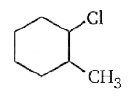Which alkyl halide exhibits complete racemisation in reaction?
The correct Answer is:D
To determine which alkyl halide exhibits complete racemization in an SN1 reaction, we need to analyze the stability of the carbocations formed during the reaction. Here’s a step-by-step breakdown of the solution:
Step 1: Understand the SN1 Mechanism
The SN1 (substitution nucleophilic unimolecular) reaction involves two steps:
1. Formation of a carbocation after the leaving group departs.
2. Nucleophilic attack on the planar carbocation, which can occur from either side, leading to racemization.
Step 2: Analyze the Given Options
We have four alkyl halides to consider:
1. CH3C(Cl)(CH3) - 2-chloro-2-methylpropane
2. CH3CH2CH2CH2Cl - 1-chlorobutane
3. CH3CH2Cl - 1-chloroethane
4. C6H5CH2Cl - benzyl chloride
Step 3: Determine Carbocation Stability
- Option 1: 2-chloro-2-methylpropane forms a tertiary carbocation, which is stable but not the most stable.
- Option 2: 1-chlorobutane forms a primary carbocation, which is less stable.
- Option 3: 1-chloroethane also forms a primary carbocation, which is even less stable.
- Option 4: Benzyl chloride forms a benzylic carbocation, which is highly stable due to resonance stabilization.
Step 4: Identify the Most Stable Carbocation
Among the carbocations formed:
- The benzylic carbocation (from benzyl chloride) is the most stable due to resonance.
- The tertiary carbocation (from 2-chloro-2-methylpropane) is stable but not as stable as the benzylic carbocation.
- Primary carbocations (from 1-chlorobutane and 1-chloroethane) are the least stable.
Step 5: Conclusion on Racemization
The stability of the carbocation directly affects the racemization. The more stable the carbocation, the more likely it is to lead to complete racemization when attacked by a nucleophile from either side.
Since the benzyl carbocation is the most stable, benzyl chloride will exhibit complete racemization in an SN1 reaction.
Final Answer
The alkyl halide that exhibits complete racemization in an SN1 reaction is benzyl chloride (C6H5CH2Cl).
---
The SN1 (substitution nucleophilic unimolecular) reaction involves two steps:
1. Formation of a carbocation after the leaving group departs.
2. Nucleophilic attack on the planar carbocation, which can occur from either side, leading to racemization.
We have four alkyl halides to consider:
1. CH3C(Cl)(CH3) - 2-chloro-2-methylpropane
2. CH3CH2CH2CH2Cl - 1-chlorobutane
3. CH3CH2Cl - 1-chloroethane
4. C6H5CH2Cl - benzyl chloride
- Option 1: 2-chloro-2-methylpropane forms a tertiary carbocation, which is stable but not the most stable.
- Option 2: 1-chlorobutane forms a primary carbocation, which is less stable.
- Option 3: 1-chloroethane also forms a primary carbocation, which is even less stable.
- Option 4: Benzyl chloride forms a benzylic carbocation, which is highly stable due to resonance stabilization.
Among the carbocations formed:
- The benzylic carbocation (from benzyl chloride) is the most stable due to resonance.
- The tertiary carbocation (from 2-chloro-2-methylpropane) is stable but not as stable as the benzylic carbocation.
- Primary carbocations (from 1-chlorobutane and 1-chloroethane) are the least stable.
The stability of the carbocation directly affects the racemization. The more stable the carbocation, the more likely it is to lead to complete racemization when attacked by a nucleophile from either side.
The alkyl halide that exhibits complete racemization in an SN1 reaction is benzyl chloride (C6H5CH2Cl).
Topper's Solved these Questions
- HALOALKANES AND HALOARENESBook:NCERT FINGERTPS ENGLISHChapter:HALOALKANES AND HALOARENESExercise:Higher order thinking skills
Explore 8 Videos
- HALOALKANES AND HALOARENESBook:NCERT FINGERTPS ENGLISHChapter:HALOALKANES AND HALOARENESExercise:Exemplar problems
Explore 24 Videos
- HALOALKANES AND HALOARENESBook:NCERT FINGERTPS ENGLISHChapter:HALOALKANES AND HALOARENESExercise:Physical properties
Explore 7 Videos
- GENERAL PRINCIPLES AND PROCESSES OF ISOLATION OF ELEMENTSBook:NCERT FINGERTPS ENGLISHChapter:GENERAL PRINCIPLES AND PROCESSES OF ISOLATION OF ELEMENTSExercise:Assertion And Reason
Explore 15 Videos
- POLYMERS Book:NCERT FINGERTPS ENGLISHChapter:POLYMERS Exercise:NCERT Exemplar
Explore 9 Videos
Similar Questions
Knowledge Check
Which of the following alkyl halide undergo rearrangement in SN1 reaction ?
ACH3−CH3∣C∣CH3−C∣IH−CH3B C
C DAll of these
DAll of theseWhich alkyl halide has maximum density ?
AC3H7IBC2H5ICCH3IDCH3BrWhich of the following alkyl halides give most complex mixture of alkene in an E2 reaction ?
ACH3−CH2−CH2−CH2−BrBCH3−CH2−CH2−C∣BrH−CH3CCH3−CH2−C∣BrH−CH2−CH3DCH3−CH3∣C∣Br−CH2−CH3
Among the choices of alkyl bromide , the least reactive bromide in a SN2 reaction is :
View SolutionAssertion: SN1 reaction proceeds with racemisation while SN1 reaction proceeds with complete stereochemical inversion.
Reason: SN2 is two steps reaction while SN1 is one step reaction.
View SolutionAliphatic nucleophilic substitution is mainly of two type SN1 and SN2.SN2 reaction proceed with strong nucleophile in polar aprotic solvent. 3∘ halides do not give SN2 reaction. Inverted products are obtained in this reaction and mechanism of reaction occurs through the formation of transition state.
SN1 reaction proceed through the formation of carbocation in polar aprotic solvent. Solvent itself acts as nucleophile in this reaction. Racemization takes place in SN1 reaction.
Which one of the following will give racemised product in C2H5OH ?
View SolutionAliphatic nucleophilic substitution is mainly of two type SN1 and SN2.SN2 reaction proceed with strong nucleophile in polar aprotic solvent. 3∘ halides do not give SN2 reaction. Inverted products are obtained in this reaction and mechanism of reaction occurs through the formation of transition state.
SN1 reaction proceed through the formation of carbocation in polar aprotic solvent. Solvent itself acts as nucleophile in this reaction. Racemization takes place in SN1 reaction.
Which of the following compounds will give SN1 reaction?
View SolutionAliphatic nucleophilic substitution is mainly of two type SN1 and SN2.SN2 reaction proceed with strong nucleophile in polar aprotic solvent. 3∘ halides do not give SN2 reaction. Inverted products are obtained in this reaction and mechanism of reaction occurs through the formation of transition state.
SN1 reaction proceed through the formation of carbocation in polar aprotic solvent. Solvent itself acts as nucleophile in this reaction. Racemization takes place in SN1 reaction.
Which one of the following will give SN2 reaction ?
View Solution

